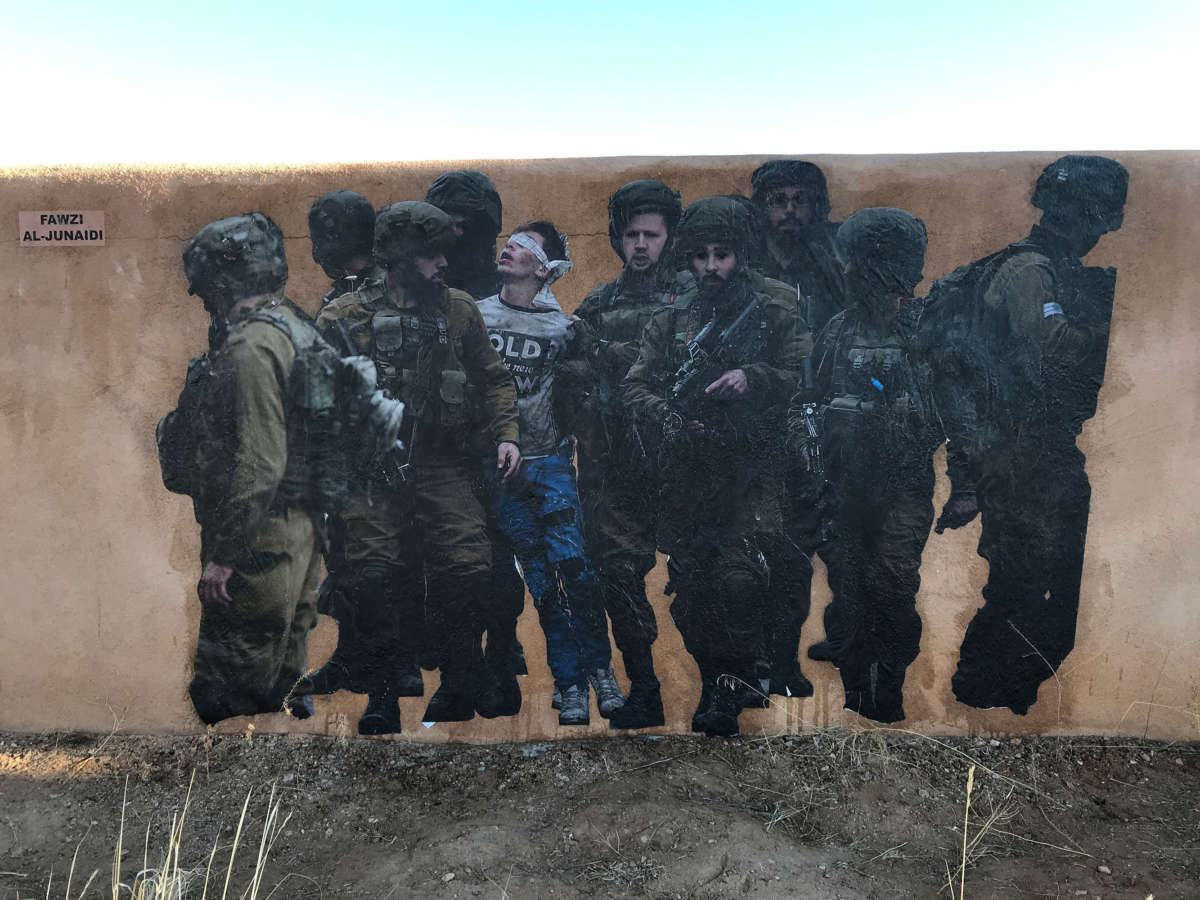Part of the Series
Struggle and Solidarity: Writing Toward Palestinian Liberation
Did you know that Truthout is a nonprofit and independently funded by readers like you? If you value what we do, please support our work with a donation.
The stucco wall on Santa Fe’s Old Pecos Trail is now embedded with papier-mâché images of Israeli soldiers terrorizing Palestinian women and children. This art was created by Navajo artist Remy. For the past six years, Santa Feans for Justice in Palestine (SFJP), of which I am a member, have been creating art depicting the conditions of Palestinians under the Israeli occupation. Guthrie Miller, the owner of the wall where the art has been located since 2014, has supported this effort. His wall abuts one of the main thoroughfares leading into Santa Fe, and is also on the cross street leading to Museum Hill, where Native American Art and history are displayed in several prestigious museums.
Our art began with wheat-pasting the names, photos and biographies of 12 children killed in the Israeli bombings of Gaza in 2014. More recently, the photos contain images of unarmed Palestinians murdered by Israeli snipers during Gaza’s March of Return and photos of midnight raids by Israel Defense Forces (IDF) soldiers blindfolding, jailing and terrorizing Palestinian children. The images on our signs have been routinely desecrated and vandalized, some after two weeks and some after two months. Our most recent sign in December displayed five 6-year-old Palestinian girls in winter coats with the caption, “These Palestinian Children Are Just Like Yours.” This graphic, like those preceding it for the past three years, was confined to one panel of the wall and most recently to a 3’ x 5’ sign, authorized by the city. The nonthreatening photo of the Palestinian girls was torn apart within 72 hours.
In response, on January 5, Remy wheat-pasted to six of the large 9’ by 6’ stucco wall panels life-size images of IDF forces, arresting, threatening, intimidating and pointing gun and tank barrels at Palestinian children, some of whom had been killed. There is a large caption in a middle panel reading “End Military Aid to Israel.”
The images are jarring and meant to awaken the public to what our tax dollars are doing and get support for the Congressional bill to stop funding Israel’s use of military courts, judges and soldiers to threaten, intimidate and, in some instances, torture Palestinian children. Remy also pointed to how the art reminds us that Israel’s actions mirror the atrocities committed by the U.S. against its own Indigenous population. He stated that the images of armed Israeli soldiers and tanks confronting Palestinian women and children show “the similarities when you look at the Indigenous struggle of this continent and the Indigenous struggle there.”
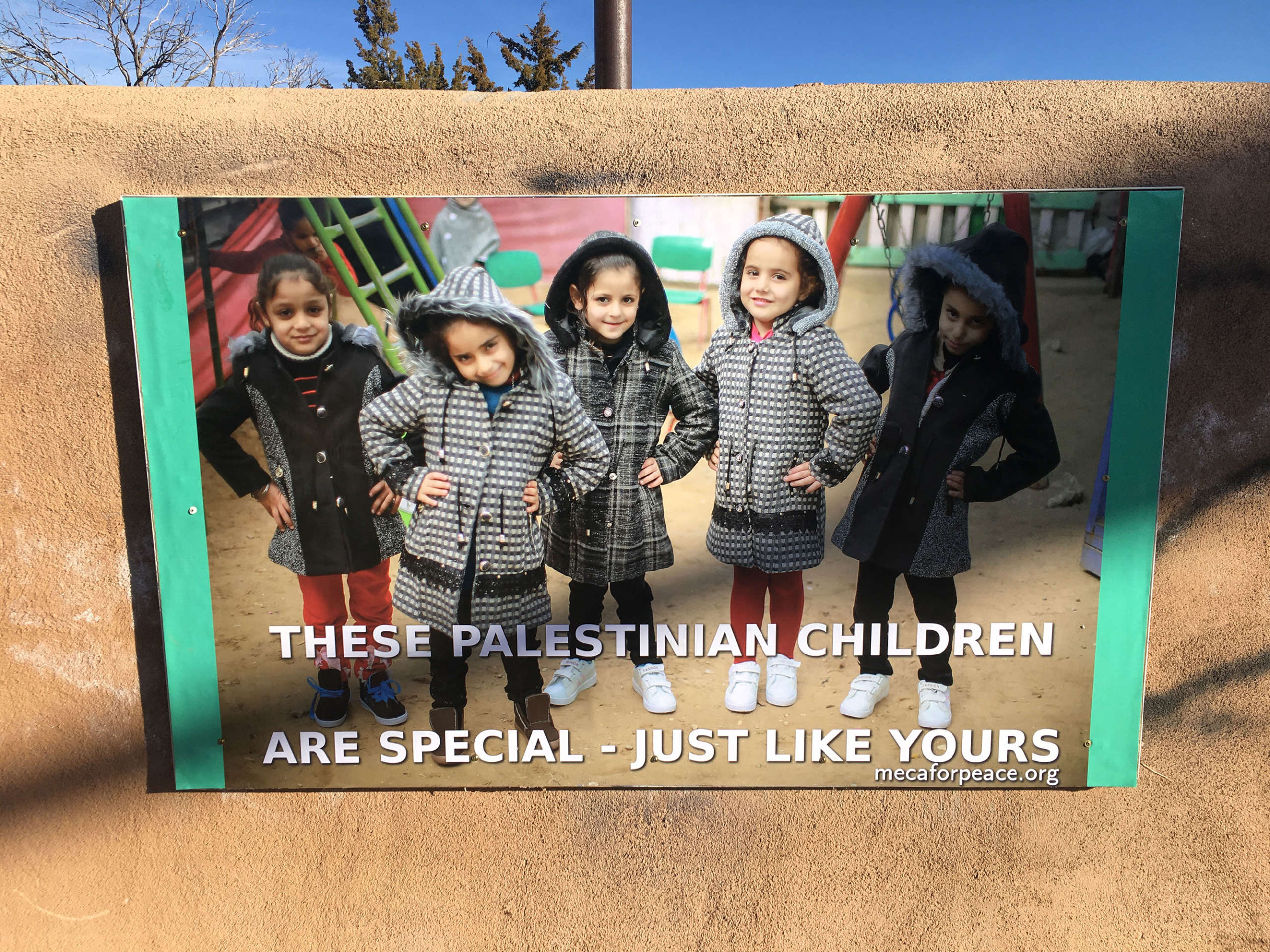
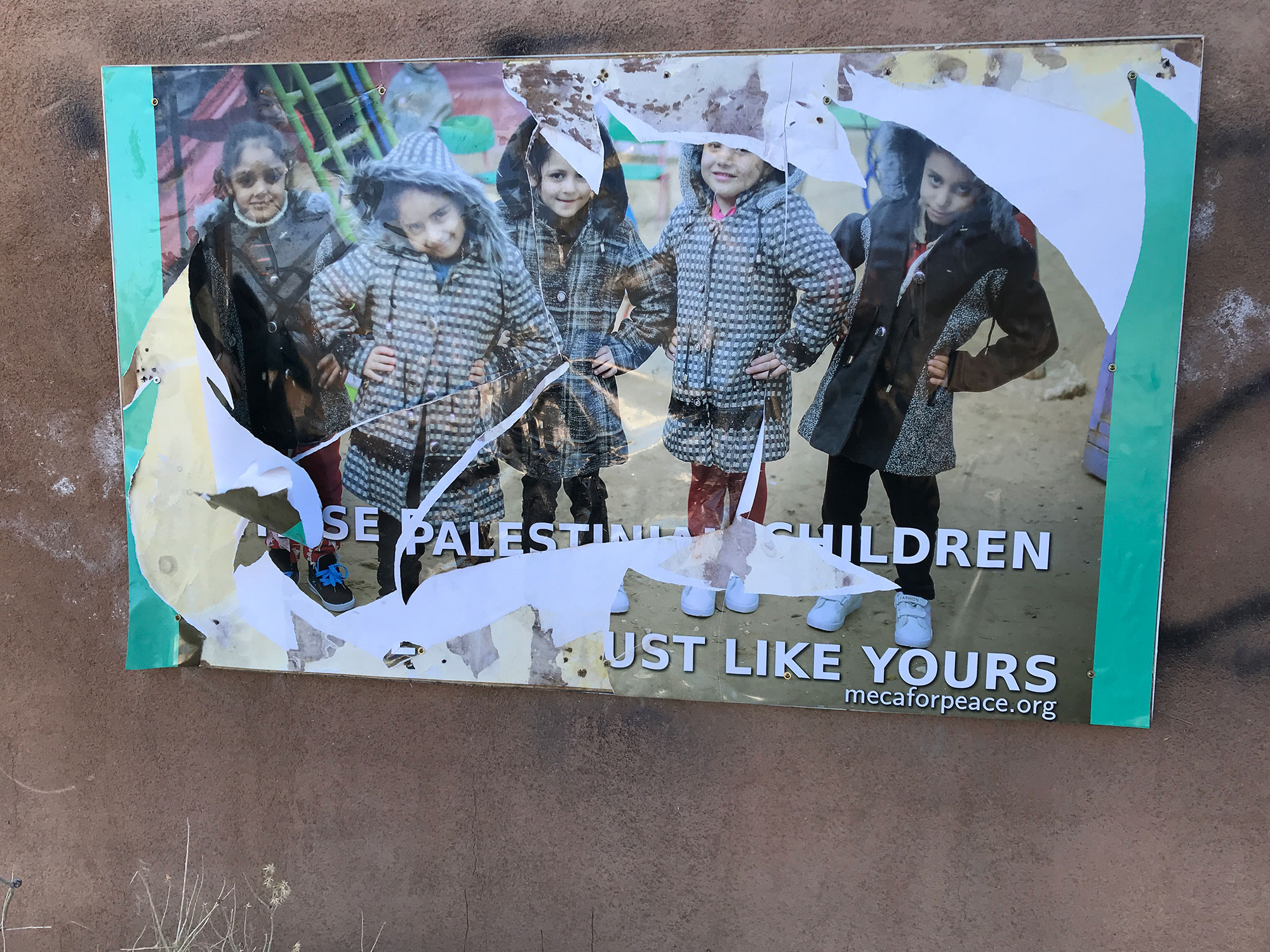
The Santa Fe New Mexican and the Albuquerque Journal have written stories reproducing the images, and the comment section has mirrored the conflicting reactions. The New Mexican reported that the local Jewish community was “sharply divided.” Not surprisingly, a local rabbi has labeled the wall art as “anti-Semitic” — a term he and many others inaccurately apply to exposures of Israel’s shameful treatment of Palestinians. This is part of a conscious effort to suppress the dialogue and provide Israel with immunity from criticism of its deadly policies. (As many Jewish critics have pointed out, conflating critique of Israel with anti-Semitism is a dangerous game.) Meanwhile, the Santa Fe and Albuquerque chapters of Jewish Voice for Peace and The Red Nation have actively supported and defended the art as a reminder of the injustices perpetrated against Palestinians and other Indigenous people.
In the face of this controversy, we maintain that it is important for us to display this art in public. Why? Because the opinions of people in the U.S. matter, when it comes to Israel’s actions. Without U.S. military, financial and diplomatic backing, Israel could not carry out rampant human rights abuses such as home demolitions, imprisonment of the entire population of Gaza, and putting its people “on a diet” to advance its apartheid objectives. Our images are intended to get the onlookers to oppose U.S.-sponsored Israeli state terrorism, just as the iconic photo of the Vietnamese girl running from a U.S. napalm attack shocked many into opposing the Vietnam War.
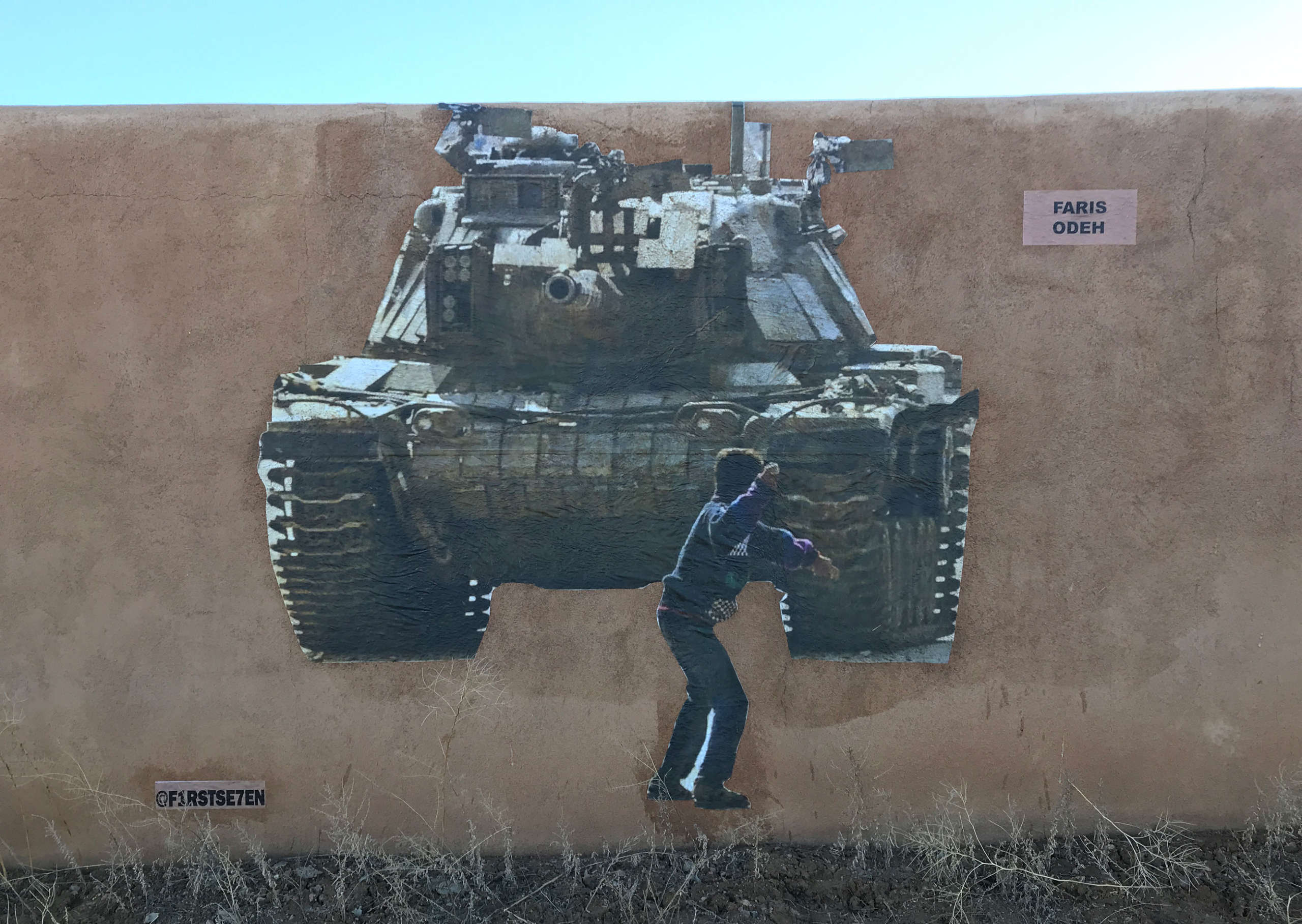
On January 8, a representative from the Santa Fe historic district came to the home of Guthrie Miller, the property owner of the wall and informed him that if he came to City Hall and applied for a permit, he would get administrative approval for the wall art. Guthrie met Lisa Roach, Historic Preservation Division manager and Eli Isaacson, acting Land Use Department director on January 10 and again was told that approval would be granted.
By midday on Monday, January 13, Santa Fe New Mexican reporter Robert Nott was also informed by the land department that the permit would be granted. Nevertheless, on Monday afternoon, Santa Fe City spokeswoman Lilia Chacon announced that homeowner Guthrie Miller “will not be receiving administrative approval to keep the mural up because the medium (papier-mâché) is not allowed in the historic district.”
In fact, the municipal code is totally silent about the medium for wall art, neither allowing nor prohibiting any medium, and Guthrie’s wall complies with requirements for stucco walls. The letter to Guthrie on January 14 offered the same pretext for the denial as Chacon’s and was in fact signed by Roach, who had never raised the issue of the medium previously, nor had she objected to it in her meetings with Miller.
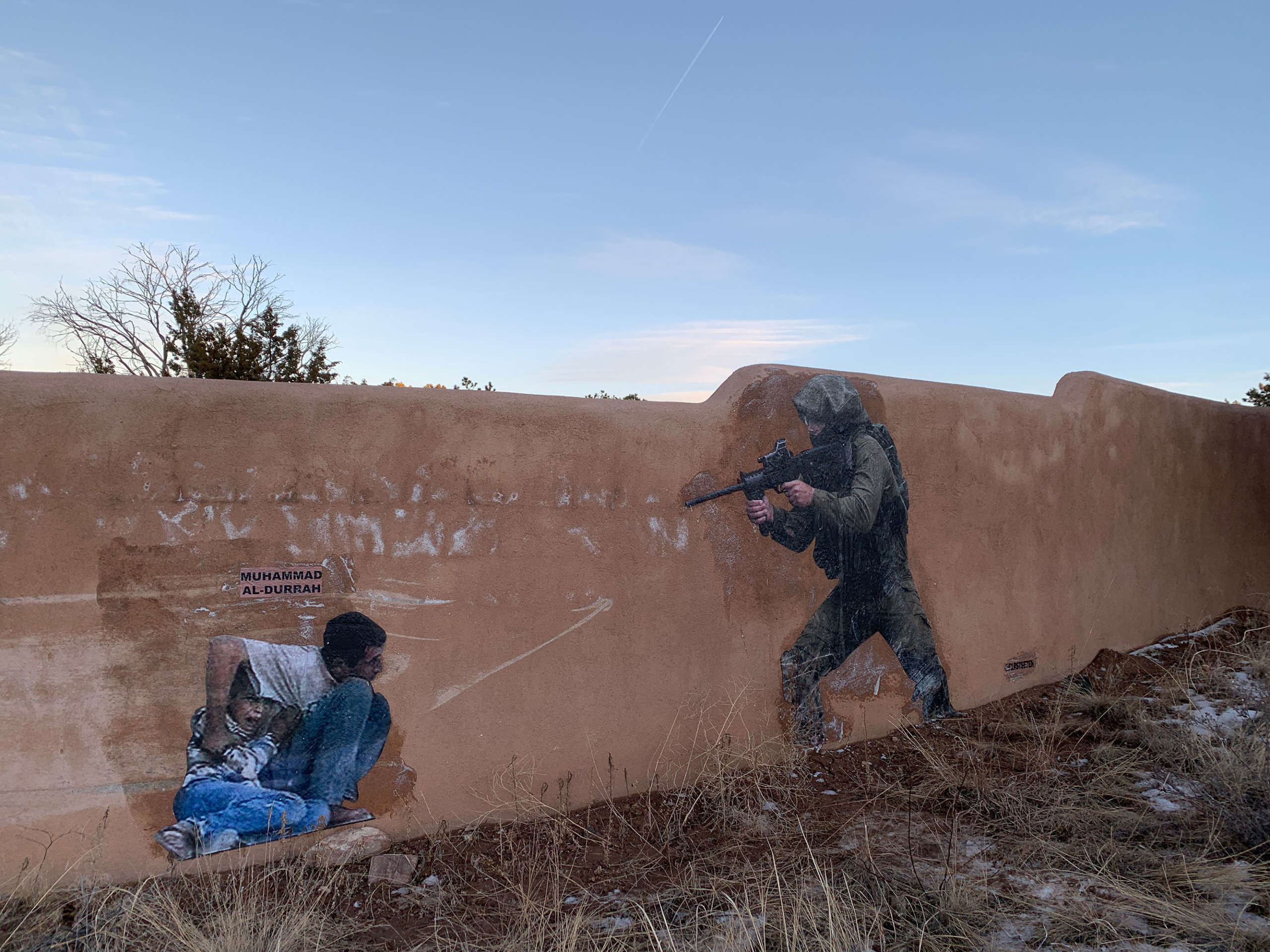
One must conclude that the real reason for the denial is likely the content, not the medium, of the murals. Despite the fact that many young people, including many young Jews, are more sympathetic to the Palestinians than the Israeli government, many older people and institutions — and the evangelicals and authoritarians within the U.S. government — give uncritical support to Israel and seek to silence its critics by labeling them anti-Semitic. The wall art images contradict the narrative of Israel as the victim. They are not intended to be pleasant, because the conditions Palestinians face in Gaza and the other occupied territories within Israel are abhorrent, deadly and dehumanizing. The purpose of the art is to confront and sensitize people about what they and their government are facilitating, and the devastating effects of funding the Israeli military. It is to make these impacts known, so onlookers will be morally outraged and oppose U.S. support of the abuses of the Israeli military. The message is not just about what the IDF is doing, but about our complicity. To reject that complicity, we must demand that our country stop funding the Israeli military until it complies with international and human rights law.
There are concrete ways to take political action on this issue right now. One is to urge our representatives to support Rep. Betty McCullom’s pending H.R. 2407 (“No Way to Treat a child”), which would cut off U.S. funding to the Israeli military’s treatment of Palestinian children. Thus far, our New Mexico representatives have ignored this plea despite the fact that Israel is the only country to apply military law to juveniles.
Meanwhile, back in Sante Fe, wall owner Guthrie Miller has appealed the ruling, which could ban all mural art in the historic district because no permissible medium is set forth in the code. Guthrie and SFJP believe the current denial of a permit is a violation of the First Amendment, which does not allow for banning free expression based on the content being disagreeable to some. Opponents of the art will argue it has no relevance in Santa Fe. Many see military funding of Israel as only a foreign policy issue, but it becomes of domestic importance when candidates court Zionist and Evangelical support and money by competing for giving the most military aid to Israel. The appeal to maintain the art points out that Santa Fe’s contribution to funding the Israel military from 2009 to 2018 was $14,593,839 — which could have funded hundreds of people seeking affordable housing, green jobs training, early reading programs or primary health care.
The sign and art wars will continue — as does the struggle of the Palestinian people for freedom and equality.
Media that fights fascism
Truthout is funded almost entirely by readers — that’s why we can speak truth to power and cut against the mainstream narrative. But independent journalists at Truthout face mounting political repression under Trump.
We rely on your support to survive McCarthyist censorship. Please make a tax-deductible one-time or monthly donation.
